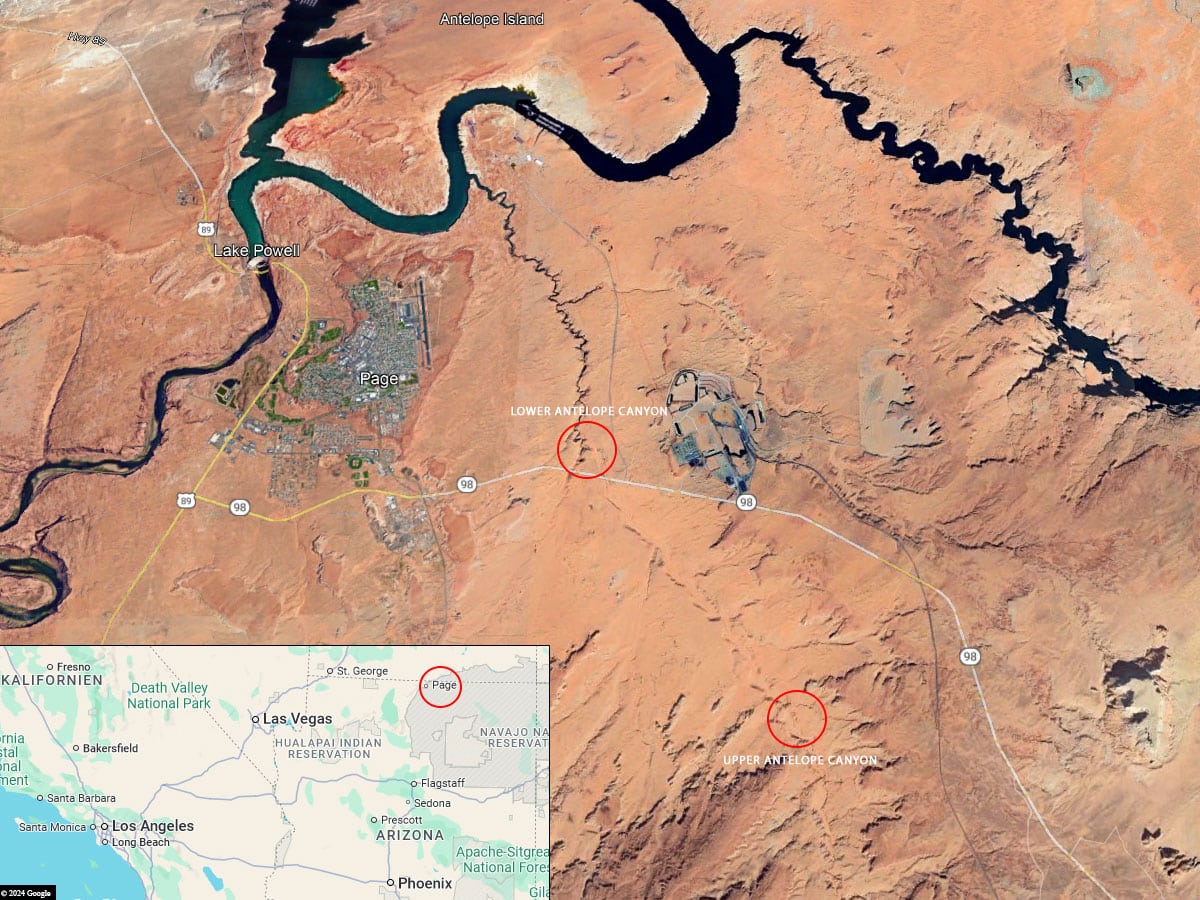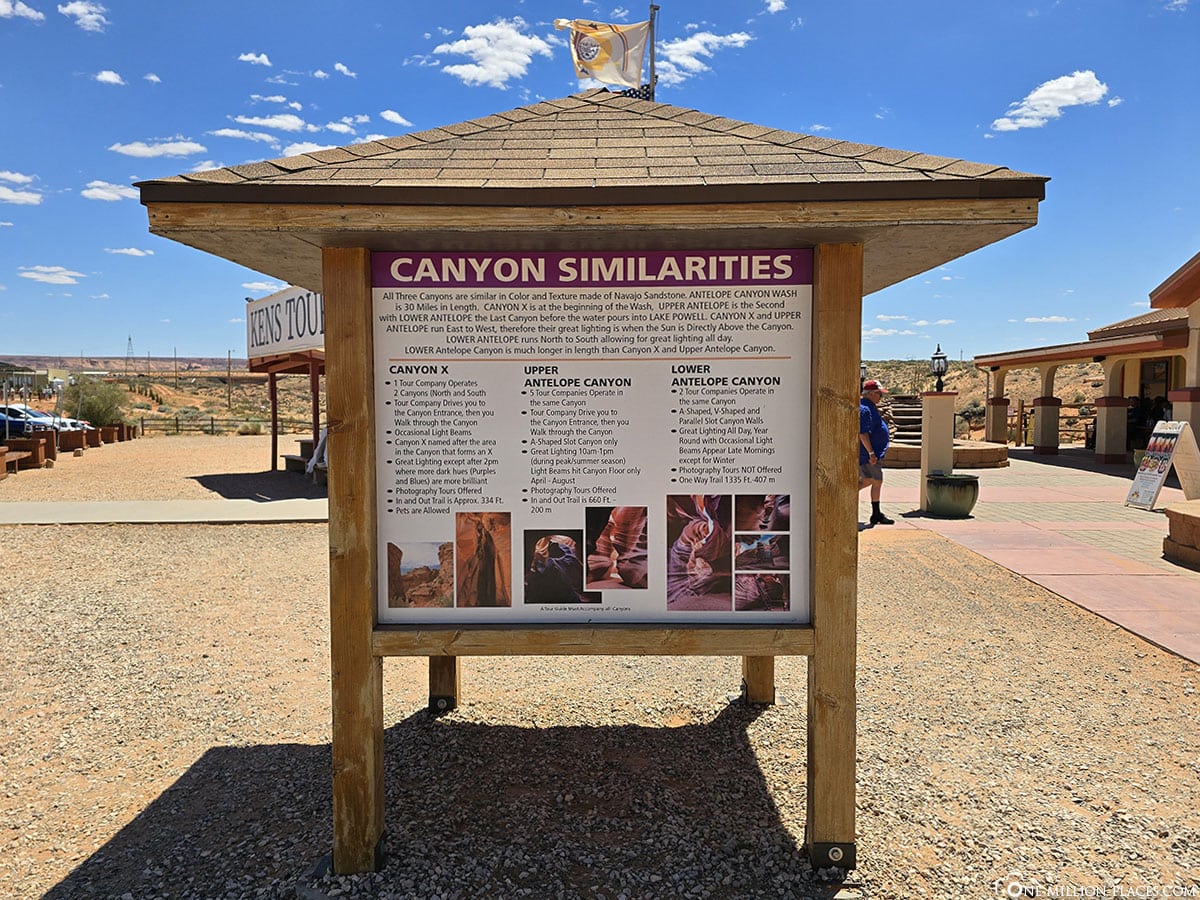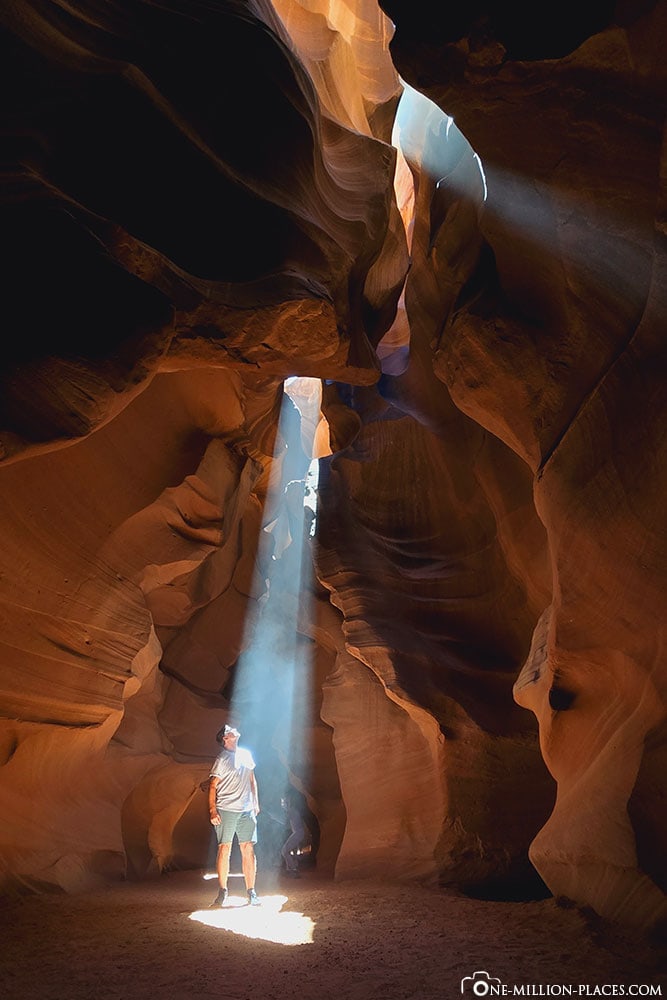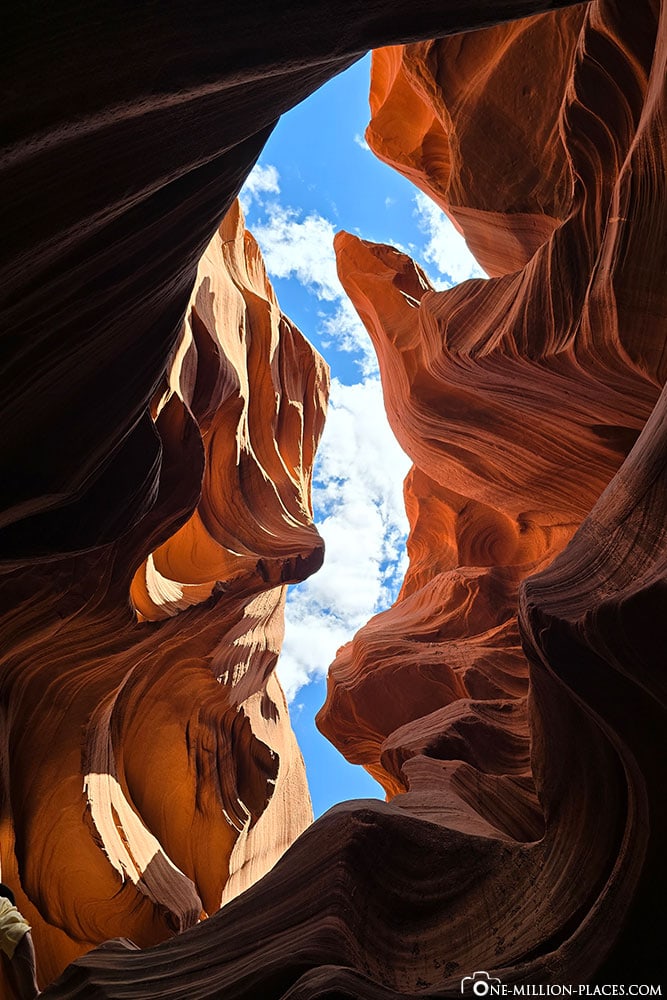After our visit to Horseshoe Bend and Glen Canyon, there was another highlight on the program for us in Page: a visit to Antelope Canyon. In the run-up to our trip, we did a lot of research into which canyon and which tour would be best for us to do as a family. We share our experiences with you in our travel report on Antelope Canyon.

Table of contents
Interesting facts about the Antelope Canyon
Antelope Canyon is a famous slot canyon in northern Arizona and is characterized by its impressive, undulating rock formations. It was created by the erosion of sandstone, with flash floods over thousands of years washing out the soft rock and forming the narrow, winding gorges. These erosion processes are still active today, and occasional floods can inundate the canyon in a matter of minutes, making it a dynamic and dangerous place in rainy weather.
The canyon consists of three parts: the Upper Antelope Canyon (“The Crack”), the Lower Antelope Canyon (“The Corkscrew”) and the X-Canyon. The Upper Antelope Canyon is about 200 meters long and more easily accessible, making it one of the most popular tourist attractions. It is only a few meters wide at its narrowest point, resulting in the famous rays of light that refract through narrow openings at the top of the canyon. Lower Antelope Canyon is longer and narrower, requiring more agility and climbing skills from visitors. The canyons are part of the Navajo reservation, and access is only possible on guided tours to protect visitors and preserve the fragile site.
Around 250,000 tourists visit the Antelope Canyon every year, which is particularly popular with photographers. Particularly in the summer months, when the sun is at an optimal angle, spectacular plays of light are created that make the canyon glow in vibrant shades of orange, red and purple. Due to its popularity, Antelope Canyon is often fully booked and it is advisable to book a tour early.
Where is Antelope Canyon located?
Antelope Canyon is located in the north of the US state of Arizona, near the town of Page and Lake Powell. It is located on the Navajo reservation.
Good to know: Arizona is in the Mountain Standard Time zone (UTC -7) and most of the state does not observe daylight saving time. However, Antelope Canyon is located on the Navajo Indian Reservation and summer time is observed here. Mountain Daylight Time (UTC -6) actually applies here from March to November. However, as most visitors to Antelope Canyon come from Page, where daylight saving time does not change, the tour operators at Antelope Canyon also keep to Mountain Standard Time during the summer months. So just go by the time in Page for the tours😉
Upper Canyon, Lower Canyon or X-Canyon – what are the differences?
Upper Antelope Canyon, Lower Antelope Canyon and X-Canyon differ in their geological formations, accessibility, number of visitors and tour operators. Here are the most important differences:
Upper Antelope Canyon
Tour operator: 5
Access: Easily accessible, flat floor, therefore ideal for people of all fitness levels.
Lighting conditions: Known for spectacular rays of light (especially in summer around midday) that fall through the narrow openings in the ceiling of the canyon.
Width and height: Narrower and higher than the Lower Canyon, which creates a more intense feeling of narrowness and height.
Tourist crowds: Very popular and often overcrowded. Guided tours are compulsory.
Lower Antelope Canyon
Tour operator: 2
Access: Access requires some climbing via metal steps and narrow passages. It is more challenging than the Upper Canyon.
Lighting conditions: Fewer rays of light than in the Upper Canyon, but still impressive colors and shapes.
Width and height: Less high, but with a narrow, winding structure, resulting in a more adventurous experience.
Tourist crowds: Generally less crowded than the Upper Canyon, but still well visited.
X-Canyon
Access: This canyon is less known and less visited than the other two. Access is relatively easy, but a guided tour is still required.
Tour operator: 1
Lighting conditions: As the name suggests, the X-Canyon has a cross-shaped opening that creates unique lighting effects. There are also light beams, but they are less prominent than in Upper Antelope Canyon.
Width and height: X Canyon is wider and not as deep or narrow as Upper or Lower Antelope Canyon. This makes it appear more open.
Tourist crowds: Significantly less frequented, which makes it attractive for visitors looking for a quieter and more private experience.
To summarize:
– Upper Antelope Canyon: Easy access, famous light beams, high visitor numbers.
– Lower Antelope Canyon: Challenging access, winding formations, fewer light beams, fewer people.
– X-Canyon: Less known, fewer people, unique light conditions and a quieter experience.
We have found a pretty good overview of the similarities and differences between the 3 canyons here.
Can you visit the Antelope Canyon on your own?
Unfortunately not. It used to be possible, but since 1997 you can still visit the canyons as part of a guided tour.
The reason for this is a tragic catastrophe in Lower Antelope Canyon, in which 11 people lost their lives. On August 12, 1997, the region was hit by a sudden downpour that fell in the higher areas away from the canyon. The thunderstorm came down 17 miles away, and the sun was shining in Page that day. The rainfall triggered a flash flood that flowed through the narrow slot canyon at enormous speed. As the canyon is extremely narrow and deep, masses of water can reach great heights in a short time and there are few opportunities for people to escape the flood.
There were several tourists in the canyon at the time, including a group of international tourists. The flash flood took them completely by surprise, as it had not rained in the immediate vicinity of the canyon. Although there had been a warning of possible flooding, there were no suitable safety precautions such as escape routes or safe havens in the canyon. Unfortunately, only one of the people who were in the canyon at the time survived this flash flood – a tour guide who managed to hold on to a rock face.
Be sure to check out the video of what a flash flood looks like in Antelope Canyon > YouTube
This tragic accident led to a significant tightening of safety regulations for access to Antelope Canyon. Since then, guided tours have been obligatory and visitors are warned in good time of impending storms. In addition, sirens and early warning systems were installed in order to better assess the risk of flash floods.
Admission, parking lot and best time
The best time to visit Antelope Canyon is between 11:00 am and 1:00 pm, especially in summer. During this time, the sun’s rays are at their highest and can fall through the narrow openings of the canyon directly onto the ground, creating the famous rays of light.
Parking spaces are available free of charge at the tour providers.
The prices for the tours are usually between EUR 50 and EUR 150 per person, depending on the canyon, tour provider and time of day.
Guided tours through the Antelope Canyon
We opted for a tour with “Tse Bighanilini Tours” through the Upper Antelope Canyon (11:15 am – 12:45 pm for $130) and with “Ken Tours” through the Lower Antelope Canyon (2:00 pm – 3:00 pm for $55) via GetYourGuide. Unfortunately, we didn’t have time for a tour through the X-Canyon.
Offers for tours with GetYourGuide
Upper Antelope Canyon
Here is our tour report from Upper Antelope Canyon.
Tse Bighanilini Tours
We booked our tour through the Upper Antelope Canyon through the provider “Tse Bighanilini Tours”. The meeting point for the tour is only about 5 minutes from the town of Page. There is a large parking lot at AZ-98 (location in Google Maps) and here you can check in for the booked tour.
Jeep tour to the Upper Antelope Canyon
With a jeep and 11 people, we then walked for about 15 minutes along a sandy and bumpy path to the entrance of the canyon. Here you can already see the rush for the canyon, there were probably 20 jeeps from different providers parked.
Entrance to Upper Antelope Canyon
The entrance to Upper Antelope Canyon is a large vertical crevice. It looks relatively unspectacular from the outside, but it is the starting point to another world 😉 Before entering the canyon, our guide explained a little about its history and formation. You also get tips for the best settings on your Android or Apple cell phone so that the colors of the canyon are highlighted particularly well in the pictures.
Tour through the canyon
The deeper you go into the canyon, the more impressive the scenery becomes. The canyon has cut deep into the rock and light keeps filtering down from above. The Upper Canyon is relatively wide and high, so there is always enough space. Nevertheless, the rush is of course so great that there is a group in front of you, you yourself are waiting in a group of 11 people and behind you the next group is already waiting in the wings. So you don’t really have much time to contemplate the beauty of the canyon in peace, let alone take photos without strangers…
The spectacular sunbeams in the canyon
The highlight in the Upper Canyon are the “Sunbeams”. These rays of light are created when the sunlight falls into the canyon and shines through the narrow crevices and winding rock formations. Especially in the summer months, when the sun is high in the sky at midday, the light penetrates almost vertically through the narrow openings and creates the fascinating rays that bathe the canyon in a magical atmosphere.
These sunbeams are made visible by the fine dust in the air that is whirled up from the walls and floor of the canyon.
The special thing about these sunbeams is that you don’t just see them in one place in the canyon. We have actually been able to observe them in 4 different places. It was also really great that the guides here take photos of the visitors.
Path through the canyon
We hiked through the canyon for a good 45 minutes in total. And around every corner there were new exciting field formations to marvel at. We could have spent the whole day here and taken thousands of photos 🙂
Exit from the canyon
At some point, you reach the end of the Upper Canyon and are back out in the open.
Return to the jeep
From the exit of the canyon, a well-maintained path leads back to the meeting point of the jeeps.
Lower Antelope Canyon
Here is our tour report on Lower Antelope Canyon.
Ken Tours
Similar to the Upper Canyon, the meeting point for the tours is about 5 minutes outside the town of Page on AZ-98 (location in Google Maps). Here, too, you have to register briefly for your booked tour and are then sent to a waiting area.
Hike & descent to the entrance of the canyon
Groups of around 20 people then walk to the entrance of the canyon. The path is at ground level and easy to walk. Only the descent into the canyon is a little more challenging. A narrow and steep staircase leads down several steps into the canyon.
Tour through the canyon
In contrast to the Upper Canyon, the Lower Canyon is much narrower and not quite as high. The path leads deeper and deeper into the canyon and there is a fascinating new photo opportunity at every turn!
Unfortunately, we couldn’t see any sunbeams in Lower Antelope Canyon, but the beauty of the canyon is still gigantic. And the path through the canyon is an experience in itself: again and again you have to cross narrow crevices, keep your head down or climb up a few steps. Our daughter really enjoyed walking through the canyon.
Silhouette of a seahorse in Lower Antelope Canyon
It is always worth taking a look upwards. Our tour guide drew our attention to a spot where the opening of the canyon looks like the silhouette of a seahorse. Cool, right? 🙂
Exit from the canyon
After about 45 minutes, you reach the exit of Lower Antelope Canyon via several narrow steps. From here it is only a few meters back to the parking lot.
Is a visit to Antelope Canyon worthwhile?
DEFINITELY YES! 🙂 We found it incredibly impressive to hike through the narrow, winding gorges with their wave-like patterns and to see the fascinating sunbeams. We are always amazed at how beautiful our nature can be!
Antelope Canyon with children or babies?
We did a lot of research on this in advance. And you can generally take children and babies into all canyons. But…
Lower Antelope Canyon with children?
We had decided to only do the Lower Antelope Canyon with children. Here you really don’t have to walk far from the parking lot to the entrance of the canyon and the canyon itself is also easily accessible. You should only watch out for children on the steps down into the canyon and at the end at the exit. With Ken Tours in Lower Antelope Canyon, children aged 0-3 are even free, children aged 4 and over pay the full price, currently $55.
Upper Antelope Canyon with children?
As you can only get to Upper Antelope Canyon and X-Canyon on a jeep tour and the road there is very bumpy in places, we decided not to do this tour with our children. According to the Tse Bighanilini Tours website, however, “all ages are welcome”. However, even babies pay the full price of adults on a tour! For 2 small children, that’s just under $300 at the best time of day. For this reason alone, we had decided to do the Upper Canyon without children, so Michael went on the tour here alone.




